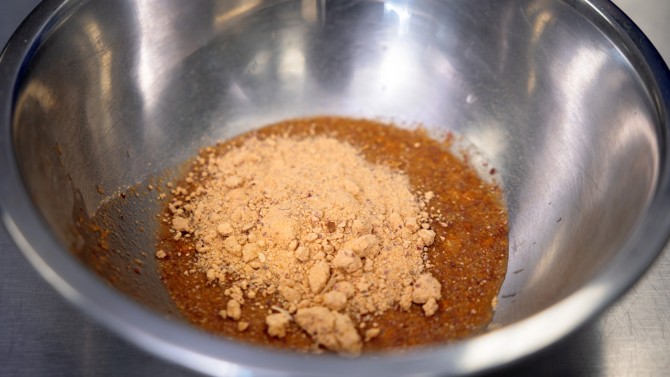Every year, as the presses churn and the sweet smell of cider fills the autumn air, more than 4 million tons of apple byproducts are hauled off as animal feed, compost or landfill waste. But a new Cornell study offers apple skins, seeds, cores and pulp a different ending.
Freeze-dried and milled into a fine powder, the byproduct, known as pomace, can be blended into commercial beef meatballs at levels up to 20% without turning off consumers, according to a new study published Sept. 12 in the Journal of Food Science and Nutrition. In sensory panels of more than 100 untrained tasters, the meatballs with apple pomace were indistinguishable in aroma, taste, texture and overall preference from all meat formulations.
Doctoral student Peter Gracey works in a kitchen in Stocking Hall.
"It's a great source of fiber and bioactives," said corresponding author Elad Tako, associate professor of food science in the College of Agriculture and Life Sciences. "But as an ingredient, it also has an antioxidant effect and contributes to a longer shelf life for food products."
The finding is more than a kitchen curiosity. It also points toward a potential new revenue stream for apple and cider producers in New York state and a practical way to close a circular loop in food manufacturing. Rather than paying to dispose of pomace, processors could freeze-dry and sell it as a value-added ingredient to meat packers, food manufacturers and specialty producers.
That shift could trim disposal costs, reduce methane emissions from landfills and capture additional dollars from a resource now treated as waste. At the same time, it could increase dietary fiber content in popular processed foods and modestly reduce the share of animal protein without changing the eating experience.
"I've always had a passion for sustainability," said Peter Gracey, first author and doctoral student in Tako's lab. "There have been other experiments exploring the use of grape and apple pomace as an ingredient in other meat products."
Gracey said they tested a realistic commercial scenario. They bought Cortland, Empire and Red Delicious apples at wholesale, pressed them at a commercial juice press, then freeze-dried the leftover pomace for 48 hours. After milling the dried material to a consistent particle size, they rehydrated it and blended it into 80% lean ground beef at 10% and 20% inclusion rates.
Beyond the tasting panels, they measured texture, color, composition and cooking yields. The 20% formulations did show a drop in cooking yield and a shift in internal color that might matter to manufacturers who need to meet specification standards. But the sensory panel did not penalize the higher inclusion levels, suggesting consumers may accept small changes if the product is otherwise familiar.
The benefits flow in multiple directions, Tako said. For cider makers and juice processors, pomace accounts for an estimated 25-30% of the total fruit mass. Handling that volume is expensive. Transportation and disposal costs can eat into already tight margins, especially for small and mid-sized processors. Turning pomace into a dry, shelf-stable ingredient means less waste-hauling and a marketable product that could be packaged, sold and distributed. For regional processors seeking new revenue streams, the approach could be appealing.
For meat producers, the ingredient adds pectin, fiber, polyphenols and micronutrients - all benefits that could be advertised in a "better for you" food package. Many populations fall short on recommended fiber intake. Adding fruit-derived fiber to processed meat products could help close that gap without asking consumers to change deeply ingrained habits. The approach may be especially useful in institutional settings such as schools, hospitals and workplaces where familiar comfort foods are served at scale, according to the researchers, among them Olga Padilla-Zakour, Seneca Foods Foundation Professor and director of the Food Venture Center, Cornell AgriTech.
From a climate perspective, diverting pomace from landfills curbs methane emissions and reduces the environmental footprint of juice and cider production. Replacing part of the meat in processed foods with plant material lowers the embedded greenhouse gas intensity of those items. The study cites research indicating that substantial reductions in processed and red meat consumption could lead to steep declines in food-system emissions.
Globally, apple production topped 97 million metric tons in 2023. New York state is the second-largest apple producer in the U.S., home to thousands of apple growers and a growing number of small cider houses and juice operations. The prospect of a local market for pomace could keep dollars within regional supply chains, according to Tako. Instead of trucking wet waste to distant composting sites, a processor in the Finger Lakes could partner with a meat co-packer or snack-food manufacturer in the region.
The exact size of the potential market will depend on a string of practical issues, Gracey said: how much pomace producers can economically dry, how quickly they can supply consistent lots and whether food manufacturers will invest in formulation and labeling changes. Freeze-drying preserves bioactive compounds and structure, but it is energy-intensive and requires capital equipment or third-party services. Simpler drying technologies might work, too, but would need careful validation to preserve color, flavor and food safety.
If adopted, Tako said, "it's a win-win-win. It could mean more natural, better-for-you products for meat companies and the people who care about getting enough protein and other nutrients, but also provide a new income stream for apple and cider producers."









